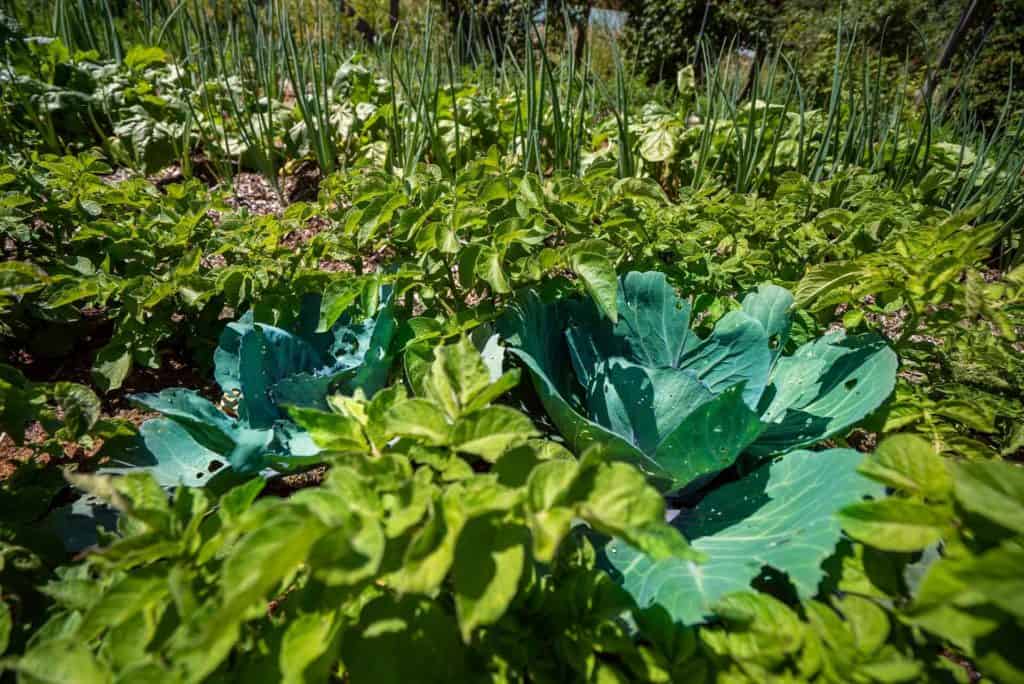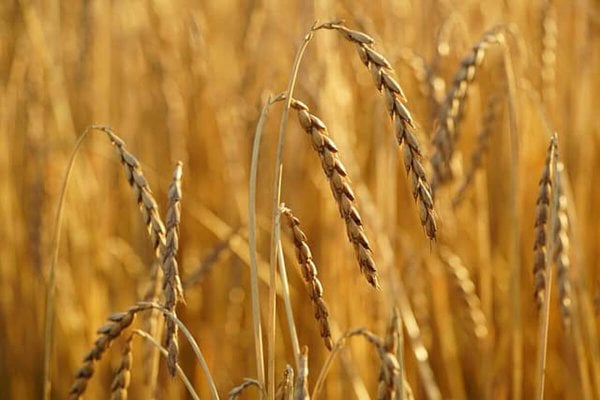Looking for natural ways to keep pests away from your plants? Good news! You don’t need harsh chemicals. You can use the power of nature to defend your garden. Use this guide to learn the secrets of natural garden pest control.

Table of Contents
ToggleWhy Natural Garden Pest Control Matters
As homesteaders, we strive to take steps toward self-sufficiency by growing a year’s worth of food using permaculture principles and, in the process, avoiding pesticide chemicals and common toxins. A study found that 90% of Americans have pesticide chemicals in their urine, and they get them mainly from eating non-organic fruits and veggies. (Source)
This awareness is enough motivation for us to adapt organic growing practices to avoid the use of conventional pesticides. We are also protecting the health of our soil, beneficial pollinators, groundwater, pets, and wildlife.
Each year, we watch as our soil becomes more fertile, biodiversity increases, and our harvests become more abundant, knowing all of this is due in part to practicing natural garden pest control.
What Is Natural Garden Pest Control

When considering natural garden pest control, you might assume that it means using organic sprays to treat infestations, but it goes beyond that. In fact, using organic sprays should be your last resort and final step.
Before using sprays or other treatments, we follow these steps:
- Healthy Soil
- Garden Hygiene
- Companion Planting
- Timing Planting, Harvest & Quantity
- Attract Beneficial Insects
- Barriers and Traps
- Removing By Hand
- Grow What Works!
Healthy Soil

A resilient garden always begins with healthy soil. When digging down into fertile soil, our naked eye can identify the activity of worms, ants, and other beneficial insects. However, what we can’t see are the millions of bacteria, protozoa, fungi, and nematodes creating a diverse and living ecosystem.
Garden pests are more likely to prey on weak plants, so growing strong and resilient plants will naturally create a deterrent. Here are tips you can use to build healthy soil:
- Test Your Soil – When you test your soil, you know exactly where it is on the pH scale. This gives you direction on what your garden needs and a reference to track as your soil improves.
- Add Organic Matter – Make homemade compost and add it to your garden to increase organic diversity and improve your soil’s ability to absorb water and oxygen.
- Use the No-Till Method – Soil disturbance and compaction from tilling suppress the life in your soil. The no-till gardening method encourages soil fertility, allows better root growth for plants, and even reduces weeds!
- Use Mulch – Adding a layer of mulch protects from soil erosion, moderates soil temperature to protect plants’ root systems and suppresses weed growth.
- Practice Crop Rotation – Soil micro and macronutrients deplete when planting the same crop in the same location year after year. By practicing crop rotation, you end up with healthier soil, less disease, and decreased pest pressure.
Garden Hygiene

Just like our health depends on maintaining the cleanliness of our homes, gardens depend on us maintaining our garden beds, tools, and supplies.
Follow these seed-starting tips to get your seedlings off to a healthy start. Prepare your garden each fall for the next growing season, and always keep your gardening tools in good working order.
Companion Planting

Pairing certain vegetables with flowers can keep pests away. For instance, marigolds next to tomatoes deter the blackfly due to their smell. Sage with carrots helps keep pests at bay because of its strong scent. Nasturtiums can protect your cabbages by diverting caterpillars.
Learn more about these combinations and how to implement companion planting in your garden here.
Timing Planting, Harvest & Quantity

When planting crops, we like to stagger our planting so we get an early summer and a late summer harvest. This can be done by starting seeds indoors and transplanting into the garden as soon as the soil is warm enough (or using cold-weather growing strategies).
By eliminating the middle of the summer when plants are growing, we can reduce our pest pressure when they tend to be the worst.
Here in North Idaho, we know that as soon as the canola fields are harvested, we’ll get an influx of flea beetles. If we can harvest most of our brassicas before the canola harvest, we’ve found the pest pressure on them is drastically reduced.
Even in our short growing window, we can plant another crop of brassicas after the worst of the pests have diminished and get an early fall harvest. Learn what vegetables you can plant in late summer for a fall harvest here.
Beyond the timing of planting, we like to focus on the amount. When growing a crop that we know has heavy pest pressure, we’ll grow extras knowing that some of them will be decimated by pests and unable to harvest. These “sacrificial crops” give the pests what they want while still giving us a harvest.
Attract Beneficial Bugs & Predators

Insects are all around us, and many are actually good for our gardens. For example, we want to attract pollinators such as bees, butterflies and moths. That’s why it’s best not to use harmful chemicals in your garden.
Other insects are helpful because they love eating soft pests. Ladybugs, parasitic wasps, lacewings, hoverflies, and minute pirate bugs are some.
For instance, wasps are great at eating aphids. Let them build nests where they don’t bother you, and never worry about aphids. Parasitic wasps can also reduce tomato hornworm numbers.
To attract ladybugs, lacewings, and similar insects, plant certain flowers like dill, fennel, parsley, thyme, and basil. Marigolds and sweet alyssum also work well.
Growing these flowers helps create a place where natural predators thrive. They can then tackle aphids and caterpillars in your garden.
When growing perennials, it’s also a great idea to set up houses for various birds and even bats. Once a pest begins to establish itself in your garden, these predators can help reduce or completely eliminate the pest.
Barriers and Traps


One easy way to avoid pests is to create barriers to stop pests from feasting on your plants.
Try using a super-fine mesh netting known as insect barrier mesh or Enviromesh. This netting is so fine that it allows water and sunlight through, but flying insects can’t sneak past it.
Use insect mesh to keep carrot flies off your carrots. It also stops the pests that cause damage to brassicas. Covering your crops can save cabbage heads from bugs and mother insects from laying eggs on them.
For deer, fences need to be at least 8 feet tall. You can also use a lower double fence. Additionally, bags can protect fruits, like tomatoes and grapes, from damage, and traps are the best defense against slugs and snails.
Additionally, you can grow trap crops for pests. Nasturtiums (specifically the orange and yellow varieties) are a great trap crop for attracting insects that would otherwise decimate your brassicas. Instead, the insects will eat the nasturtiums, and your crop will be less affected.
Removing By Hand

When you regularly monitor your garden, early detection and manual removal can often be sufficient.
A strong water blast can get rid of many pests and it’s effective against insect eggs, larvae, and mature bugs. This method is good for soft-bodied insects like aphids and mites.
If you identify an infestation, remove and squash any bugs and eggs you find, and cut off any part of the damaged plant to stop them from spreading. If necessary, remove the entire plant. It’s better to lose one plant than an entire crop.
If you see larger predators (such as slugs or tomato hornworms), remove them and place them in a bucket of soapy water. Or, save them to feed your chickens!
Grow What Works!

When you grow what works for your region, especially crops that don’t tend to get much pest pressure, your harvests will be abundant. For us, we like to focus on winter squash. Not only do they preserve themselves, but they double as animal feed, and we can grow extra, knowing we won’t eat all of them ourselves.
If you know a crop grows well in your area, focus on it (or other crops in the same family) and stop fighting so much to grow what doesn’t do well in your region.
Organic Sprays and Natural Remedies

By following the steps above, you will drastically reduce the need for organic sprays by simply reducing pest pressure. However, it’s a good idea to know what natural pesticides are available in the event you should need them.
Proper precautions should be taken to protect beneficial pollinators, such as using correct dilution, spraying in the morning or late evening before or after pollinators are active, avoiding spraying when plants are in bloom and avoiding spraying near hives.
- DIY Soap Spray – Making your own spray is easy. Just mix a teaspoon of dish soap with a pint of water, and shake it well before application. Use it sparingly to avoid harming your plants.
- Cold-Pressed Organic Neem Oil – Neem oil is extracted from the seeds of the neem tree and works as a general insecticide by suffocating insects and disrupting their hormones. As a bonus, Neem oil also works as a fungicide.
- Diatomaceous Earth – Diatomaceous earth (or DE) is a powder made from fossilized diatoms. While it can work on soft-bodied insects, it’s most commonly used on hard-shelled insects by destroying their exoskeletons and dehydrating them. DE can be damaging to lung tissue if inhaled, so be gentle in your application and never use it on a windy day. Reapplication may be necessary if it rains or the DE gets washed away from watering.
- Pyrethrin Extract – Pyrethrin extract is made from flowers that contain high amounts of pyrethrin, such as chrysanthemums. It works as a general insecticide by damaging the insect’s nervous system.
- Spinosad – Spinosad is created through aerobic fermentation of the soil bacterium Saccharopolyspora spinosa. It works on a wide variety of insects by damaging their nervous systems when they come into contact with it.
- Bt – Bt, or Bacillus thuringiensis, is a naturally occurring bacteria that is only effective on pests that consume it during their larvae stage. There is some controversy surrounding Bt, as it has also been used to genetically modify crops to produce Bacillus thuringiensis.
- DIY Fruit Fly Trap – When fruit flies become an issue on fruit and vegetables from the garden, I use a homemade solution of vinegar and dish soap to make a DIY fruit fly trap.
Getting Started With Permaculture

By going natural, not only do your plants benefit, but the whole ecosystem does, too. A little knowledge and choosing green methods over harmful ones can lead to big, positive impacts.
To help put this into practice, we have developed a 50-minute crash course teaching you the basics of permaculture and how it can make your homestead, garden and home produce more with less effort.
Sign up today to gain instant access to…
- 12 Basic Design Principles for a more efficient homestead
- 4 Action Steps to take right now for a smoother running homestead or home
- 6 Garden Tips for a healthier and more productive garden
Other Posts You May Enjoy

- How to Grow a Year’s Worth of Food
- 3 Things You Must Do To Increase Self-Sufficiency
- Permaculture Design + Mistakes to Avoid When Designing Your Permaculture Homestead
- Our Journey With Glyphosate Toxicity
- How to Test Soil pH
- No-Till Gardening – Is It Right For You?
- Crop Rotation in a Vegetable Garden


















